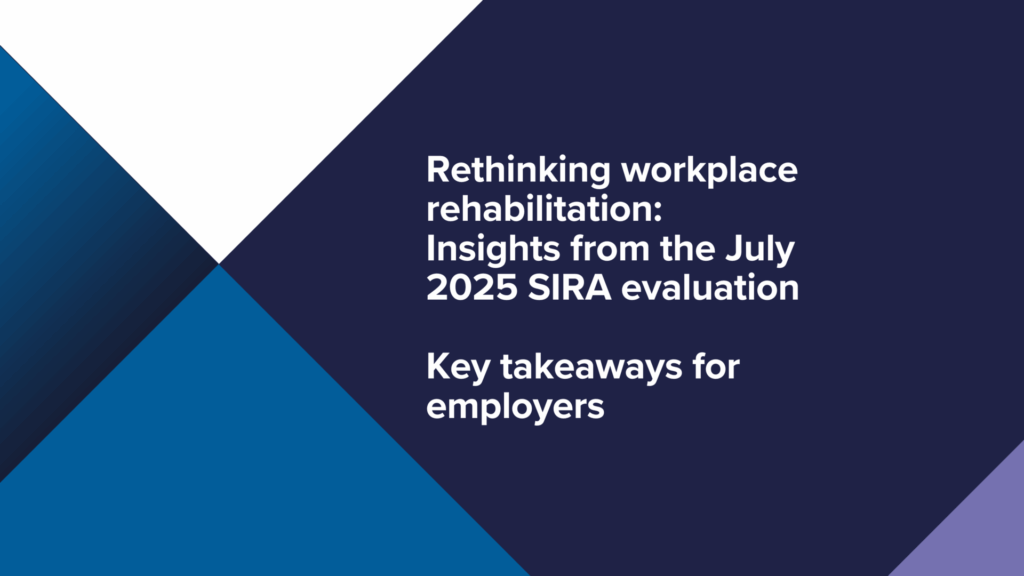If you want to make a positive step this year to ensure a safer and more productive workplace, it’s a good idea to get into the habit of having a risk assessment when one is needed.
So, what does a risk assessment involve?
A risk assessment is usually completed in the workplace by a qualified assessor, who will watch one or more of your staff members at work and observe how they complete their tasks.
Any person or any role can be assessed, but more often than not, the tasks are those that are regarded as more ‘high risk’ due to the demands of the task, or due to the higher volume of incidents or near misses that occur.
The assessment is all about getting a thorough understanding of the role, the working environment and the risks.
Key areas that an assessor will look at include:
- Manual handling practices and demands
- Postural issues
- Environmental impacts
- Physical tasks
- Psychological demands
Once the assessor has a detailed picture, they can then develop and tailor alternate strategies for that particular person and role to help mitigate against these risks.
Usually, this follows what’s referred to as the ‘hierarchy of control’.
The hierarchy of control is a system used across industries to control workplace risks.
It’s a step-by-step approach to eliminating or reducing risks by ranking controls from the most effective control to the least effective.
- Eliminate hazards and risks – Eliminating the hazard and risk it creates.
- Reduce the risk – Reducing the risk through substituting the risks with lesser risks, isolating people from the risks, and engineering changes or changes to systems of work.
- Administrative controls – Use administrative actions to minimise exposure to hazards and to reduce the level of harm.
- Personal protective equipment – Use personal protective equipment (PPE) to protect people from harm.
As an employer, you have a legal duty to eliminate risks to health and safety.
If it’s not reasonably practicable to eliminate risks to health and safety, you must reduce them as much as possible.
How you do this is something the team here at Interact can help you with.
It’s all about injury prevention
It goes without saying that no one wants an accident or injury to happen because of the work they do.
So when it comes to risk management in the workplace, like in all things, prevention is better than cure.
And when you’re running a business, preventing accidents and injuries has many positive flow-on benefits, such as:
- Safeguarding the business from the financial impact by reducing lost time through injuries, increased productivity, and lowered insurance premium costs.
- Increasing the team’s morale because they work for an employer that cares about their health and wellbeing.
- Retaining and attracting good people.
Developing a relationship with a risk assessment partner
When you partner with an injury prevention organisation like Interact, you’ll work with experts who will get to know your business.
So whenever injuries, near misses, or other problems arise, you have someone to call on who already understands your business, knows your team, and can address any issues and develop solutions as soon as possible.
You may have a period when you’re fortunate enough to have no incidents.
However, a risk assessment can still be beneficial.
It’s a good idea to review your known ‘high-risk’ tasks every two years or so to ensure you have the best controls in place and that your staff know the right processes and procedures to use.
It’s also an excellent opportunity to hear feedback from staff to listen to their thoughts or concerns, and their suggestions and solutions.
And it’s a chance to raise awareness of safety issues within the team, especially if there’s been staff turnover.
These risk reviews can really build the morale and wellbeing of the employees.
They see an employer proactively reviewing their high-risk task processes, procedures, and associated tools and equipment.
This sends a clear message that you care about them and their safety.
It shows you’re invested in their health and safety, which is usually repaid through a happier, more productive, and more present workforce.
Do risk assessments differ in rural NSW to metropolitan Sydney?
As a provider of vocational rehabilitation with a regional focus, the team here at Interact are often asked if there’s a difference between rural and metro areas.
Whether you do your business in a rural area or a larger town or city, the risk assessment process is generally the same – regardless of the workplace and the tasks being assessed.
However, the roles and environments you encounter in the different locations are often different.
In rural and regional areas, you’re more likely to have agricultural, mining, food processing, and manufacturing roles.
In the cities, warehousing, retail, transport, and professional services are more common.
As such, the specific risks and roles that are assessed are often different.
But one important aspect is the same – whatever region or sector you’re in, making your workplace safer and preventing injuries and accidents is not only good for your people, it’s better for business.
If you’d like to have a chat about injury prevention in your workplace, or organise a risk assessment, please get in touch with our team on 1300 618 868 or referrals@interactgroup.com.au.




